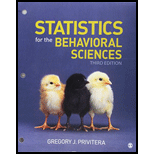
Concept explainers
1.
Find the test statistic value and make a decision to retain or reject the null hypothesis
1.
Answer to Problem 20CAP
The test statistic value is 3.
The decision is to reject the null hypothesis.
Explanation of Solution
Calculation:
Let
A sample of 10 participants observed one of two comedians is considered and they are rated 7-point scale from 1 (not likable at all) to 7 (very likable). The claim is the there is difference between the likability ratings of two groups. This represents the alternative hypothesis. The level of significance is 0.05.
Null hypothesis:
That is, there is no difference between the likability ratings of two groups.
Alternative hypothesis:
That is, there is difference between the likability ratings of two groups.
The degrees of freedom for t distribution is,
The test is two tailed, the degrees of freedom are 8, and the alpha level is 0.05.
From the Appendix C: Table C.2 the t Distribution:
- Locate the value 8 in the degrees of freedom (df) column.
- Locate the 0.05 in the proportion in Two tails combined row.
- The intersecting value that corresponds to the 8 with level of significance 0.05 is 2.306.
Decision rules:
- If the test statistic value is greater than the critical value, then reject the null hypothesis or else retain the null hypothesis.
- If the negative test statistic value is less than negative critical value, then reject the null hypothesis or else retain the null hypothesis.
The formula of test statistic for one-sample t test is,
In the formula,
In the formula,
Software procedure:
Step by step procedure to obtain test statistic value using SPSS software is given as,
- Choose Variable view.
- Under the name, enter the names as Ratings, and Comedians.
- Choose Data view, enter the data.
- Choose Analyze>Compare means>Independent Samples T Test.
- In Test variables, enter the column as Ratings.
- In Grouping variables, enter the column as Comedians.
- Select Define Groups; enter Group 1 as 1 and Group 2 as 2.
- Click OK.
Output using SPSS software is given below:


Thus, the test statistic value is 3.
Justification: The value of test statistic is 3 and critical value is 2.306. The test statistic value is greater than the critical value. The test statistic value fall under critical region and hence the null hypothesis is rejected.
2.
Find the value of estimated Cohen’s d to compute the effect size.
2.
Answer to Problem 20CAP
The value of estimated Cohen’s d is 1.90.
There is large effect size.
Explanation of Solution
Cohen’s d:
The Cohen’s d is the measure to estimate the effect size which is used most frequently for t test. In t test the value of population standard deviation is not known, hence this value is replaced with sample standard deviation for estimation the effect size as,
The Cohen’s d for a two-independent-sample t test is,
The description of effect size using Cohen’s d:
- If value of Cohen’s d is less than 0.2, then effect size is small.
- If value of Cohen’s d is in between 0.2 and 0.8, then effect size is medium.
- If value of Cohen’s d is greater than 0.8, then effect size is large.
Calculation:
From the SPSS output, the value of
The value of estimated Cohen’s d is 1.90. This value is greater than 0.8. Hence the estimated Cohen’s d has a large effect size.
Want to see more full solutions like this?
Chapter 9 Solutions
STATISTICS F/THE BEHAV.SCI. (LOOSELEAF)
 MATLAB: An Introduction with ApplicationsStatisticsISBN:9781119256830Author:Amos GilatPublisher:John Wiley & Sons Inc
MATLAB: An Introduction with ApplicationsStatisticsISBN:9781119256830Author:Amos GilatPublisher:John Wiley & Sons Inc Probability and Statistics for Engineering and th...StatisticsISBN:9781305251809Author:Jay L. DevorePublisher:Cengage Learning
Probability and Statistics for Engineering and th...StatisticsISBN:9781305251809Author:Jay L. DevorePublisher:Cengage Learning Statistics for The Behavioral Sciences (MindTap C...StatisticsISBN:9781305504912Author:Frederick J Gravetter, Larry B. WallnauPublisher:Cengage Learning
Statistics for The Behavioral Sciences (MindTap C...StatisticsISBN:9781305504912Author:Frederick J Gravetter, Larry B. WallnauPublisher:Cengage Learning Elementary Statistics: Picturing the World (7th E...StatisticsISBN:9780134683416Author:Ron Larson, Betsy FarberPublisher:PEARSON
Elementary Statistics: Picturing the World (7th E...StatisticsISBN:9780134683416Author:Ron Larson, Betsy FarberPublisher:PEARSON The Basic Practice of StatisticsStatisticsISBN:9781319042578Author:David S. Moore, William I. Notz, Michael A. FlignerPublisher:W. H. Freeman
The Basic Practice of StatisticsStatisticsISBN:9781319042578Author:David S. Moore, William I. Notz, Michael A. FlignerPublisher:W. H. Freeman Introduction to the Practice of StatisticsStatisticsISBN:9781319013387Author:David S. Moore, George P. McCabe, Bruce A. CraigPublisher:W. H. Freeman
Introduction to the Practice of StatisticsStatisticsISBN:9781319013387Author:David S. Moore, George P. McCabe, Bruce A. CraigPublisher:W. H. Freeman





